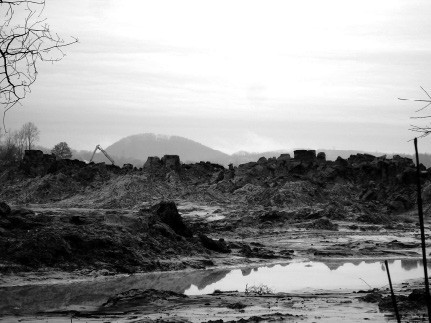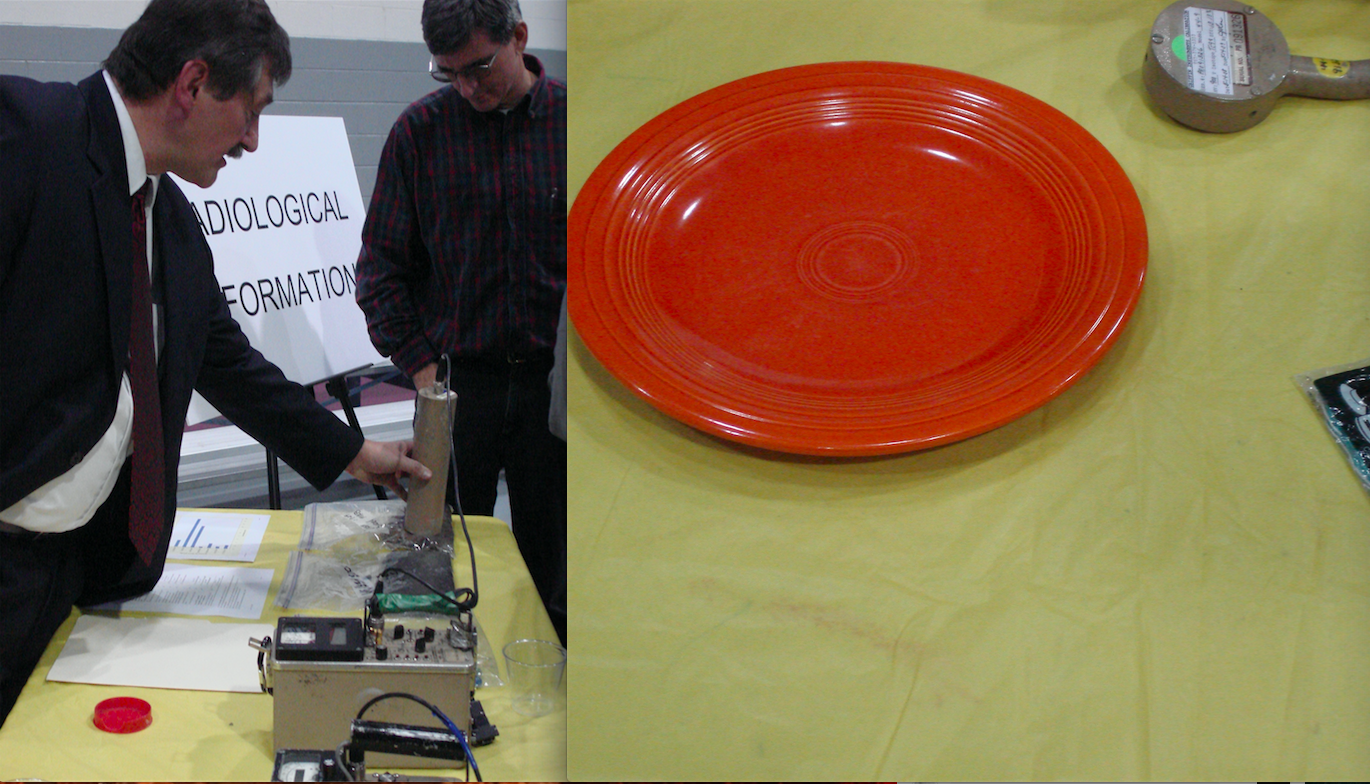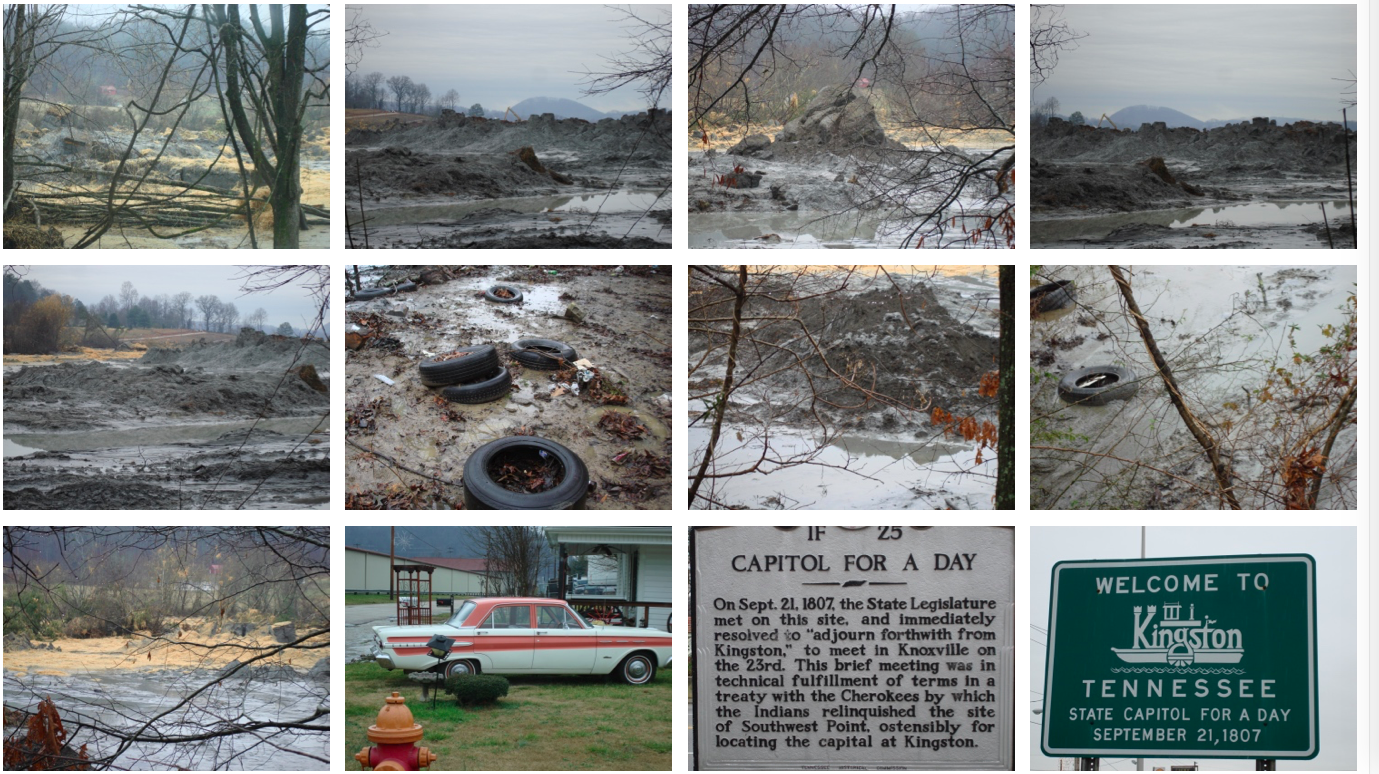
Reporters sometimes do reckless things to bring home a story. By the time I got to Kingston, TN, in January, 2009, 24-hour police barricades blocked all apparent access to TVA’s catastrophic pond breach — a massive coal ash spill NBC nightly news had described as an environmental disaster 30-times larger than the Exxon Valdez oil spill. National news organizations and environmentalists had gotten in early before safety concerns and concerns about TVA’s reputation turned the area into a forbidden zone, off limits to everybody, especially media. Of course, roadblocks are a mere speed bump for reporters armed with scribbled directions on the back of a bar napkin. Team Flyer would make it back to Memphis with photos of the “ash-bergs,” as the enormous toxic sludge formations were being called, even if it meant playing a little Smokey and the Bandit.
I’m reminded of the scene in Kingston by Gannett’s sobering report highlighting extraordinary information quietly buried in a TVA earnings report. The utility is finally admitting that ratepayers may soon be on the hook for legal settlements against Jacobs Engineering, a contractor working for TVA that has admitted under oath to misleading 900 employees about the risks of coal ash exposure. This news follows 40 deaths and more than 400 reported ailments ranging from respiratory problems and rashes to heart disorders, neurological disorders and cancer.
Via Gannett:
A jury in U.S. District Court in November ruled Jacobs violated its contract with TVA for the cleanup work and endangered workers as a result. That trial revealed TVA ratepayers had paid Jacobs $60 million for that contract work.
I’m not posting today to revisit past adventures in journalism or to advance Gannett’s top notch summation of what’s transpired over the past decade. In keeping with a recent theme on this blog, I’d rather look back to the weeks immediately following the disaster. Knowing what we know now, I’d like to look at this in terms of access and transparency and think about what happens when there’s a disaster and information is treated like a private concern rather than a public good. 
If you have the time, I recommend taking a look at “Shades of Gray,” my vintage coverage of the Kingston disaster, published as a Memphis Flyer cover story shortly after the event. I think it makes a good companion to Gannett’s latest revelation and retrospective. Like the sub-head says, confusion reigned in the early days following the spill. It was driven, in part, by a concerted effort on behalf of TVA and coal-related interests to make sure the citizens of Kingston and Roane Co. had the absolute best possible information for TVA and coal-related interests.
Via me, 2009:
A nattily dressed man with snow-white hair waited patiently, then, when he got his turn at the microphone, erupted like a volcano: “Who can I trust? Tell me, who can I trust?” he asked, his voice quivering.
The man ran down a list cataloging the incongruous viewpoints he’d been subjected to for 18 days — the time that had passed since the waste-retaining wall at the TVA’s Kingston Fossil Plant gave way, and his hometown — once a water-lover’s paradise tucked into the postcard-perfect hills of East Tennessee — became the new synonym for environmental disaster.
“Tell me who I should trust,” he pleaded, obviously doubtful that [famous organizer Erin] Brockovich or the panel of scientists — and legal consultants from New York’s Weitz & Luxenberg law firm — assembled in the gymnasium at Roane State Community College were less self-interested than the environmentalists, media, or coal-industry spokesmen, all of whom seemed to offer conflicting answers.
“‘Who can I trust?’ was the most prescient question anybody asked,” Owen Hoffman, the president of SENES Risk Management in Oak Ridge, told The Flyer in an interview following his appearance on Brockovich’s panel. In a conversation ranging from hard science to the social dynamics at play in Kingston, he described environmentalists as being so accustomed to thankless uphill struggles, they can always be counted on to accentuate negatives while acknowledging that industry spokespeople and real-estate developers “trivialize” realistic consequences to protect financial interests.
“The ties between government and industry have been too close for many years, so it’s not unreasonable to wonder if the information we get from our government agencies is reliable,” Hoffman said.
Private industry was a notable player in the Kingston response. And while some residents were thankful for Brockovich’s contravening presence, others expressed worry about “out of town interlopers” and “sharks.” There was a lot of good reporting around the Kingston disaster, but when distinctive sides present themselves, media narratives tend to favor the controversy over the concern. That was not always the case here, but was generally as the big question became, “is this sludge REALLY ALL THAT toxic?” instead of “what’s the best way to get people the relief and recompense they deserve while managing this toxic sludge?”
“I think the public has been very poorly informed,”
one toxicologist said to the crowd at a food-and-drink-heavy event sponsored by the American Coal Ash Association (ACAA). “It’s wrong to characterize the ash as toxic sludge. That’s a pejorative term,” he said. “It’s like my wife complaining that she had to drink toxic sludge because she recently had a gastrointestinal exam and the doctor made her swallow barium.”
Via me, 2009:
On the night before Brockovich’s town hall-style meeting, another group of scientists held a different kind of gathering at Kingston’s Midtown Elementary School. Consultants from the American Coal Ash Association (ACAA) hosted a meet-and-greet event that included a massive buffet table weighted down with shrimp, meatballs, croissants stuffed with chicken salad, fruit, pastry, cookies, and a selection of exotic cheeses.
There was no official presentation, but Kingston residents could walk around and ask questions of the ACAA’s scientists…
There was also a medical doctor on hand to address — and minimize — concerns about long-term health risks and a coal-ash expert who explained how using fly ash in concrete helps mitigate the greenhouse gasses released in the coal-burning process.
“I don’t think anybody’s going to see Blinky the three-eyed fish in the river,” said Dr. Michael Bollenbacher, a radiation expert and the one showman among the ACAA’s consultants. He took on tough questions from Harriman resident John Hoage, a retired attorney who has sued tobacco companies.
Bollenbacher’s reference to Blinky was likely a response to the opening paragraphs of a 2007 article in Scientific American called “Coal Ash Is More Radioactive than Nuclear Waste” that had been making its way into e-mails all over Kingston.
Bollenbacher worked the crowd like a blackjack dealer, running a pair of Geiger counters over bags of local dirt and coal ash, as well as over typical household objects. The dirt and coal ash triggered little response from the machines, while the household objects made them screech…
“Did you hear what happened when I held it over the plate?” he asked, as if the red Fiestaware on the table was typical of contemporary kitchenware. But red Fiestaware, which hasn’t been produced for decades, is somewhat infamous for containing uranium and lead that can be leeched out by acidic foods such as tomato sauce.
“But what do I know about any of this?” Bollenbacher asked rhetorically. “I’m just a dumb scientist, an independent consultant who doesn’t have a dog in this fight.”

It’s only as radioactive as this plate.
Let’s generously presume that the ACAA’s indie consultant didn’t know the plate he used to represent an ordinary household object was infamous for tickling Geiger counters. And maybe nobody assembled at the coal-friendly event had a “dog in the fight.” But 10 years, and many deaths and illnesses later, it looks like coal ash loose in the environment might be at least a little more hazardous than dinner service.
John Hoage, a retired attorney who attended the coal-friendly eat-and-greet, wasn’t having it. Hoage, who had sued tobacco companies in the past, pulled out a folder of information he’d collected about the ACAA. He said the organization’s membership page reads like a “Who’s Who” of coal industry heavyweights. He said he didn’t think anybody was telling him the whole truth.
“All of this reminds me of the 1950s,” Hoag said. “The tobacco industry had scientists, too, and they used similar arguments to minimize the risks of cigarette smoke.”
Hoag was particularly interested in cases related to prolonged exposure to smoke — like flight attendants trapped in smoke-filled cabins. He thought this was a more apt comparison to the situation in Kingston, than odd shots of barium related to occasional medical procedures.
The TVA is admitting publicly for the first time that it made a deal that could put ratepayers on the financial hook for the misdeeds of a contractor accused of poisoning an entire workforce. https://t.co/cML7puHD0e
— knoxnews (@knoxnews) February 5, 2019
Information Control: Why TVA Ratepayers May Pay For Coal Ash Fallout (2)
Now here’s the real question: Why was there a controversy for media to report and residents/consumers to contend with in the first place? While it might be entirely true that coal ash, an ingredient in various modern building materials, can be essentially harmless when it’s stabilized by containment, that information, no matter how accurate, isn’t useful to anybody when vast quantities are dumped into the environment. To get to the bottom of things The Flyer found a scientist named Bryce Payne with a 15-year history of working on unrelated coal ash piles. He essentially affirmed the ACAA’s most optimistic claims, but that wasn’t anywhere near the end of Payne’s informed assessment.
If the ash is released from the pond and exposed to substantially different environmental conditions, as happened in Kingston, however, Payne thinks there is then a substantial chance that the previously stable elements will become unstable. If that occurs there could be a net release of the toxins “that will accumulate to potentially threatening levels.”
Also:
“Among humans, the tolerance for exposure to toxic elements can vary widely,” he explained. “Some can tolerate high exposures, some only very limited exposures. The same is true among plants and animals. Carp are a rough fish species, tolerant of pretty poor water quality. Other fish species cannot tolerate conditions that carp thrive in.”
Payne was extremely reluctant to be interviewed at the time because, in his opinion, the news media does a terrible job reporting on science. He worried about sensational treatment and that his comments would be decontextualized to support pro-environmentalist positions he wasn’t endorsing. As Memphis fans of Dr. Heckle’s science news podcast already know, bad science reporting is a legitimate concern. I think I did okay by him though, and four months later he’s quoted in The Nation expressing even grimmer concerns about the state and federally backed cleanup project:
Despite warnings that the dredging may trigger a major toxic event, the TVA, backed by federal and state officials, is following through with its plans. “There apparently has been horrendous pressure to dredge at any costs,” said Bryce Payne, an independent environmental consultant who has been working on fly ash for more than fifteen years. “But the fish and similarly vulnerable biota in the Emory and Clinch River system simply will not be able to tolerate additional selenium.”
More from The Nation — May, 2009:
Payne, who has offered his consulting services to the TVA and state regulators, wants officials to understand why so many of the best-laid plans could be heading toward disaster. In the March 20 e-mail to Sloan, he questioned the TDEC’s assumptions, pressed the agency to make its selenium data public and criticized Tennessee’s water-quality standards as too permissive regarding selenium. He zeroed in on the state agency’s pledge to follow up on fish tissue studies. The problem with fish tissue tests, he explained, is that selenium “bioaccumulates,” inching its way into fish and animals over months and years, not days and weeks. If you find selenium in high concentrations in fish tissue, the theory goes, you’re already in trouble. “[Fish tissue data] will not tell you how much more selenium may still come after you have finally detected that a threatening amount was there in the first place,” he told Sloan. In a telephone interview, Payne said that the threat was hard to detect: “Selenium, by its nature and chemistry, will sneak up on us,” Payne says. “It’s like the frog in the pot of slowly heating water.”
Among scientific experts, Payne is far from alone. “The folks in charge feel they don’t have the luxury to consider other ways to clean the river out,” said Joseph Skorupa, a biologist and selenium expert with the US Fish and Wildlife Service. “But they should understand that letting loose selenium is a momentous decision.”
So why did it take 10 years, possibly 40 deaths, and more than 400 illnesses to get a quiet admission in an earnings report that ratepayers might be on the hook for liabilities resulting from TVA’s bad stewardship at the edge of real darkness? There are lots of reasons, obviously, but I’m going to let TVA and politicians off the hook momentarily and answer in words I’ve typed too often lately — words readers will probably grow tired of seeing as I write more media and information-related posts over the next several months: Markets determine news content.
Let’s face it, producers can only squeeze so much reality appeal from the chemistry of Selenium, an element that, according to studies cited by the EPA, may result in things like “discoloration of the skin, loss of nails and hair, excessive tooth decay, listlessness, lack of mental alertness etc.” According to The Nation the agency “also labels selenium sulfide, a selenium compound, a ‘probable human carcinogen’” But that’s not my point. Responsible science reporting doesn’t make for gripping, accessible prose or TV news content attractive to the most broadly attractive consumers (to advertisers) who, according to the best sources I know on the topic, don’t give a flip about public affairs reporting. Still, many commercial newsrooms thought this story worth investing in. The Flyer, a small, typically hyperlocal newsweekly from the other side of the state, thought the incident was valuable enough to send a reporter when it happened. Regional news teams followed the story year after year and the incident only received sporadic statewide or national notice. But if the Kingston spill was 30-times larger than the Exxon Valdes disaster, it wasn’t half as hyped.
Information Control: Why TVA Ratepayers May Pay For Coal Ash Fallout
Gannett’s latest summation, as reported in its various Tennessee papers including The Commercial Appeal, accomplishes everything good newspaper reporting is supposed to do, covering and contextualizing a lot of complicated ground. But from the onset, Kingston’s narrative turned on controversy rather than urgent common cause. As is often the case with shocking events, when it stopped being breaking national news, it was never again amplified or sustained by social or legacy media long enough to force scrutiny, build mass-trust or foment opinion in the face of considerable public relations efforts by coal-related interests including, by TVA’s own self-congratulatory account,100-million in dollar diplomacy investments “that improved or enhanced Roane Co.” Not to mention that generous seafood-laden buffet I once covered. I can’t deny, those fat shrimp assured and delighted my disaster-deprived tummy all those years ago.
WBIR’s Dec., 2018 retrospective noted that TVA had given $32-million to area schools after the disaster — more dollar diplomacy. The report stated that the $1.2-billion cost of cleanup was spread out over 15 years, at no additional cost to ratepayers.
There’s a lot of blame to go around, but the worst of everything that happened in Kingston was amplified by people not knowing who to trust or to turn to for help finding good information. The death, discomfort, displacement, and personal loss is an indictment of private, state, and federal priorities. But it also represents the failures of an information industry that may never find an economic platform for sustained and meaningful public affairs reporting in the modern age. Absent that, there will always be too many deterrents, distractions and roadblocks preventing consumers from accessing the information they need and never enough barricade-evading directions scribbled on the back of bar napkins.

Yes, we dumped a bunch of coal ash in your backyard, but aren’t you hungry?


Erin Brockovich in Kingston